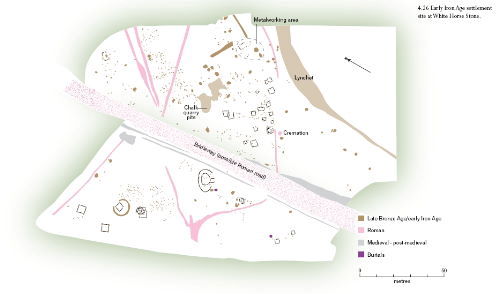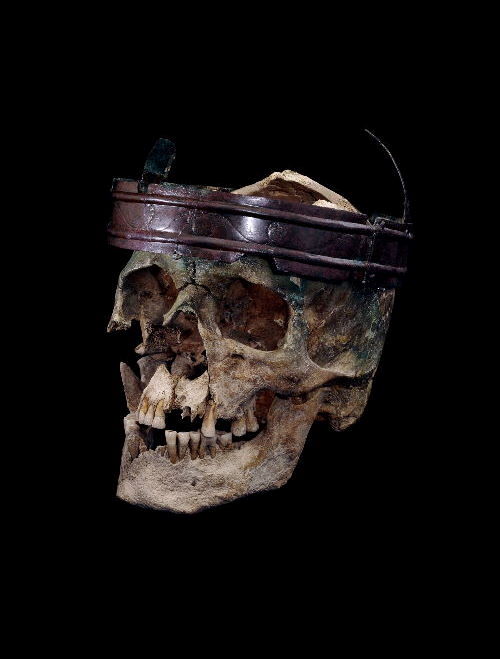800 BC to AD 42
Lyn Palmer
Introduction
From around 2700 years ago (7 00 BC), the Iron Age began in Britain. Conventionally, it ends with the arrival of Rome in AD 43. Archaeologists separate this period from the preceding Bronze Age because iron becomes the metal of choice for tools and weapons. Despite this, it was not commonly used until the late Iron Age and finds of iron from the earlier part of the first millennium BC are rare. The earliest evidence for ironworking in Kent, and amongst the earliest in Britain, is from South Street (mke15792), south of Herne Bay. A set of iron tools (a curved blade, a knife and four awls) have also been found with an early Iron Age cremation burial at White Horse Stone.
The early iron age
Contact between Kent and the continent became increasingly frequent during the Iron Age. In the closing years of the period, and for the first time in history, a written account of the people of Britain was made, by Julius Caesar who landed in Kent in 55 and 54 BC. In addition to this information (albeit written Caesar’s perspective), the archaeological evidence becomes more varied towards the end of the period. New forms of pottery, burial rite and ornament, often based on continental types, can be more closely dated and so chronologically placed. In particular, the introduction of the potter’s wheel in the first century BC led to a greater variety of forms, identifiable regionally.
The majority of known early and middle Iron Age settlements are in east Kent; by the last two centuries before AD43 a spread is evident, with concentrations along the Vale of Holmesdale and the River Darent. There is more evidence than previously of people living in the western Weald. This was perhaps because of the iron ore available there, although it was likely not mined here until the late Iron Age.

Image: Early iron age settlement at White Horse Stone
Settlement
Settlements ranged from single farmsteads to large villages, some enclosed with ditches and fences. Multiple enclosing ditches are common elsewhere in the country, but in Kent the only known example is Beechbrook Wood (mke17456), near Ashford. Houses were normally round, made of wood, wattle and daub. Although farming was well-established, the food supply was still supplemented by wild game; at Farningham Hill (mke578) in West Kent, bones of boar and deer were found with those of sheep, pig and cattle.
A handful of Kent sites have been suggested as oppida, a term used by Caesar to describe large and important centres which had political and economic similarities to Roman towns. Canterbury, Rochester and Quarry Wood Camp, Boughton Monchelsea (mke2124), may fit the criteria of dense settlement and of finds demonstrating trade with the continent.
Hillforts
Kent has a few hillforts, defended hilltop areas enclosed by large banks and ditches. Unlike those elsewhere in Britain, which were generally built early in the period, Kent’s are middle-to-late Iron Age. Oldbury (mke247), near Ightham, covers over 50 hectares, roughly the size of 50 football pitches and one of the largest hillforts in Britain. It was probably used for around 300 years before the Romans arrived. The site is managed by the National Trust and it is possible to walk around its ramparts, although they are now covered in woodland. Bigberry (mke4844) hillfort, near Harbledown in east Kent, may be the place which Caesar attacked during his abortive invasion attempt of 55BC. A Roman amphora found there reveals the occupiers continental tastes. Amongst iron objects were slave chains, fearsome links designed to fit around the necks of hapless captives. Hillforts in other areas, such as in neighbouring Sussex, were often densely occupied, but examples from Kent do not seem to be used in this way.
Iron age coins
Coins, which began to be made in the 2nd century BC in Kent, are also found in the vicinity of these proto-towns. Kent was one of the first parts of Britain to use coins, an idea copied from the continent. High value gold and silver staters were produced and lower value potins (copper alloy). Most Iron Age coinage was not used for everyday transactions as we would use coins today. The rulers of Kent are recognisable as names on coins, although these names also appear on coins originating in Essex and Sussex, giving rise to speculation that Kent was part of an area ruled from further afield.
Funerary evidence and ritual
There is a lack of burial evidence until the late Iron Age; the dead are almost invisible in the earlier part of the period. The few that have been found are in a crouched position on their side, a rite which seems to change by the middle Iron Age when the body is laid flat on its back. Eventually, cremation became the norm during the century before Rome arrived. This evolution can be seen at the cemetery of Mill Hill (mke7353), Deal, where around 50 burials of all forms have been excavated.
Sometimes pots, and occasionally metalwork, accompanied the burial. At Mill Hill, a man in his 30’s had a bronze crown on his head as well as a sword and shield. It has been thought that his headgear may have signified him to be a holy man. Cremations from Aylesford (mke2039) were within decorated wooden buckets, one nearly a metre across with iron bands and handles, another with sheets of bronze depicting horses and with dramatic stylized heads at either side of the bucket handle. Burials with weapons are known from several late Iron Age sites, amongst them Brisley Farm (mke17634), Ashford. Here, two warriors with swords, spears and shields were placed in rectangular enclosures which may have had small barrows (mounds of earth), over the top. This type of burial was similar to those on the continent.

Image: Warrior burial with crown from Mill Hill, Deal (British Museum copyright)
Iron Age religious practice was often linked to water, although there is little evidence in Kent for objects cast into water, a ritual practice begun in the Bronze Age. However, as the idea of temples spread from the continent, specialised centres began to grow up, such as the complex at Springhead (mke1632) in west Kent. This major Roman ritual site, built around the mouth of the River Ebbsfleet, had Iron Age origins. At Worth (mke7198), near Sandwich, excavation of a Roman temple revealed a long history of occupation in the Iron Age; amongst the finds were miniature bronze votive shields, suggesting ritual practices.

Image: Grave 'Y' from Aylesford
The impact of Rome
Despite Kent being the initial place of contact, the Roman invasion did not change the way that people lived overnight. Cross-channel interaction throughout the Iron Age and in particular in the last two centuries of the period meant that Kent had already absorbed many new cultural changes.
